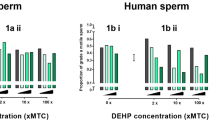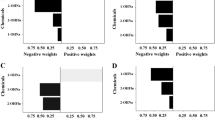Abstract
170 seminal samples from fertile men, men with idiopathic oligospermia or azoospermia and men status post vasectomy were analyzed for 74 polychlorobiphenyl (PCB) congeners,p,p′-DDE, mirex, and hexachlorobenzene using the technique of glass capillary gas chromatography with electron capture detection. Low concentrations of 32 PCB congeners were measured (mean total PCB residue of 5.8 ng/g wet weight). The application of multiple linear regression analysis to the data is described and the result is critically evaluated. There is a correlation between sperm motility and count. There are indications that the concentrations of three PCB congeners (2,4,5,2′4′5′- and 2,4,5,2′3′4′-hexachlorobiphenyl and 2,4,5,3′4′-pentachlorobiphenyl) are inversely correlated with sperm motility index in samples with a sperm count less than 20 million cells/ml. The implications of the discerned associations are discussed.
Similar content being viewed by others
References
Ballschmitter K, Zell M (1980) Analysis of polychlorinated biphenyls (PCB) by glass capillary gas chromatography. Fresinius J Anal Chem 302:20–31
Bennett AH, Rivard DJ (1983) Semen: The normal analysis, storage techniques and new concepts. Volume II. American Medical Association Update Series, Lesson 7. American Urological Association, Houston, Texas
Bleavins MF, Aulerich RJ, Bleavins MR, Ringer PK (1980) Polychlorinated biphenyls (Aroclors 1016 and 1242): Effects on survival and reproduction in minks and ferrets. Arch Environ Contam Toxicol 9:627
Bush B, Tumasonis CF, Baker RD (1974) Toxicity and persistence of PCB homologs and isomers in the avian system. Arch Environ Contam Toxicol 2:195–209
Bush B, Snow JT, Connor S (1983a) High resolution gas chromatographic analysis of nonpolar chlorinated hydrocarbons in human milk. J Assoc Offic Anal Chem 66:248
Bush B, Snow JT, Connor S, Rueckert L, Han Y, Dymerski P, Hilker D (1983b) Mirex in human milk in upstate New York. Arch Environ Contam Toxicol 12:739–746
Bush B, Lo F-C, Baker FD, Tumasonis CF, Therriault G, Zdeb M (1983c) Chronic toxicity studies of crude organic chemical pollutants, illustrated by studies with Aroclor 1254. Arch Environ Contam Toxicol 12:221–226
Bush B, Snow J, Koblintz R (1984) Polychlorobiphenyl (PCB) congeners,p,p′-DDE, and hexachlorobenzene in maternal and fetal cord blood from mothers in upstate New York. Arch Environ Contam Toxicol 13:517–527
Bush B, Snow J, Connor S, Koblintz R (1985) Polychlorinated biphenyl congeners,p,p′-DDE and hexachlorobenzene in human milk in three areas of Upstate New York. Arch Environ Contam Toxicol 14:443–450
Call DJ, Harrell BE (1974) Effects of dieldrin and polychlorinated biphenyls upon the production and morphology of Japanese quail eggs. Bull Environ Contam Toxicol 11:70
Cecil HC, Bitman JB, Lillie RJ, Fries GF (1974) Embryotoxic and teratogenic effects in unhatched fertile eggs from hens fed polychlorinated biphenyls. Bull of Environ Contam Toxicol 11:489
Cordle F, Locke R, Springer J (1982) Risk assessment in a Federal Regulatory Agency: an assessment of risk associated with the human consumption of some species of fish contaminated with polychlorinated biphenyls (PCBs). Environ Health Persp 7:171–182
Dillon JC, Martin GB, O'Brien HT (1981) Pesticides in human milk. Food Cosmet Toxicol 19:437–442
Dixon WJ (Chief Editor) (1981) BMDP Statistical Software. University of California Press, Berkeley, CA
Dougherty RC, Whitaker MJ, Tang SY, Bottcher R, Keller M, Kuehl DW (1980) Sperm density and toxic substances: A potential key to environmental health hazards. Environ Health Chem 13:263
Forgue ST, Allen JR (1982) Identification of an arene oxide metabolite of 2,2′,5,5′-tetrachlorobiphenyl by gas chromatography-mass spectroscopy. Chem Biol Interact 40:233–285
Frank R, Thomas RL, Holdrinet M, Kemp ALW, Braun HE (1979) Organochlorine insecticides and PCB in surficial sediments (1968) and sediment cores (1976) from Lake Ontario. J Great Lakes Res 5:18–27
Gierthy JF, Crane D (1985) In vitro-bioassay for dioxin-like activity based on alterations in epithelial cell proliferation and morphology. Fundam Appl Toxicol 5:754–759
Glass RI, Lynn RN (1979) Sperm count depression in pesticide applicators exposed to DBCP. Am J Epidemiol 109:346
Horn EG, Hetling LJ, Tofflemire TJ (1979) The problem of PCBs in the Hudson River system. Ann NY Acad Sci 320:591–609
Kimbrough RD (1981) Chronic toxicity of halogenated biphenyls and related compounds in animals and health effects in humans. In: Khan MHQ, Stanton RH (eds) Toxicology of halogenated hydrocarbons: health and ecological effects. Pergamon Press, New York, pp 23–37
Kosutsky J, Adamec J, Bobakova E (1979) Effects of polychlorinated biphenyls in poultry reproduction. Bull Environ Contam Toxicol 21:737
Kreiss K, Sack MM, Kimbrough RD, Needham LL, Smrek AL, Jones BT (1981) Cross-sectional study of a community with exceptional exposure to DDT. J Am Med Assoc 45:1926–1930
Kuroki H, Masuda Y (1977) Structure and concentrations of the main components of polychlorinated biphenyls retained in patients with Yusho. Chemosphere 8:469–474
Maroni M, Colombi A (1981) Occupational exposure to PCB in electrical workers: environmental and blood PCB levels. Br J Ind Med 38:49
Masuda Y, Yoshimura H (1982) Chemical analysis of polychlorinated biphenyls and dibenzofuran in relation to Yusho. J Toxicol Sci 12:161–175
McLane MAR, Hughes DL (1980) Reproductive success of screech owls fed Aroclor 1248. Arch Environ Contarn Toxicol 9:661
Mes J, Doyle JA, Adams BR, Davies DJ, Turton D (1984) Polychlorinated biphenyls and organochlorine pesticides in milk and blood of Canadian women during lactation. Arch Environ Contam Toxicol 13:217–223
Mitchell DG, Garden JS (1982) Measuring and maximizing precision in analysis based on use of calibration graphs. Talanta 29:921–929
Needham LL (1981) Polychlorinated biphenyl determination at parts-per-billion level in serum. In: CDC Laboratory Update 81-108, US Department of Health and Human Services, Atlanta, Georgia
Norstrom RJ, Gilman AP, Hallet DJ (1981) Total organically bound chlorine and bromine in Lake Ontario Herring Gull Eggs, 1977, by instrumental, neutron activation and Chromatographic methods. Sci Total Environ 20:217–230
O'Keefe PW, Meyer C, Hilker D, Aldous K, Jelus-Tyror, Dillon K, Donnelley R, Horn E, Sloan R (1983) Analysis of 2,3,7,8-tetrachloro-dibenzo-p-dioxin in Great Lakes fish. Chemosphere 12:325–332
Parkinson A, Safe SH, Robertson LW, Thomas PE, Ryan DE, Reik LM, Levin W (1983) Immunochemical quantitation of cytochrome P-450 isozymes and epoxide hydrolase in liver microsomes from polychlorinated or polybrominated bi-phenyl-treated rats. J Biol Chem 258:5967–5976
Potashnik G, Yani-Inbar, Sacks MI, Israeli R. (1979) Effects of DBCP on human testicular function. Isr J Med Sci 15:438
Rogan WJ, Bagniewska A, Danstra T (1980) Pollutants in breast milk. New England J Med 302:1450–3
Rogan JR, Gladen BC, McKinney JD, Carreras N, Hardy P, Thullen J, Tinglestat J, Tully M (1986) Polychlorinated biphenyls (PCBs) and dichlorodiphenyl dichloroethene (DDE) in human milk: effects of maternal factors and previous lactation. Am J Public Health 76:172–177
Sager DB (1983) Effects of potential exposure to PCBs on adult male reproductive function. Environ Res 31:76–94
Savage EP, Keefe TJ, Tessari JD, Wheeler HW, Applehaus FM, Goes EA, Ford SA (1981) National study of chlorinated hydrocarbon insecticide residues in human milk. I. Geographic distribution of dieldrin, heptachlor, heptachlor epoxide, chlordane, oxychlordane and mirex. Am J Epidemiol 113:413
Schwartz PM, Jacobsen SW, Fein G, Jacobson JL, Price HA (1983) Lake Michigan fish consumption as a source of polychlorinated biphenyls in fetal cord serum, maternal serum and milk. Am J Public Health 73:293–6
Seegal RF, Bush B, Brosch KO (1985) Polychlorinated biphenyls induce regional changes in brain norepinephrin concentrations in adult rat. Neurotoxicol 6:13–24
Sissons D, Welti D (1971) Structural identification of polychlorinated biphenyls in commercial mixtures by gas chromatography. J Chromatogr 60:15–32
Spagnoli J, Skinner L (1977) PCBs in fish from selected waters of New York State, Pest Monit J 11:69–87
Todd-Sanford (1962) Clinical diagnosis by laboratory methods. Sohn D, Henry (eds) 14th Edition, WB Saunders, Philadelphia, Pennsylvania, p 1203
Tuistra LGMT, Traag WA, Keukens HJ (1980) Qualitative determination of individual chlorinated biphenyls in milk fat by splitless glass capillary gas chromatography. J Assoc Offic Anal Chem 63:952–958
Waliszewski SM, Szymczynski GA (1983) Determination of selected chlorinated pesticides, bound and free, in human semen. Arch Environ Contam Toxicol 12:577–580
Whorton D, Milby TH, Krauss RM, Stubbs HA (1979) Testicular function in DBCP exposed workers. J Occup Med 21:161
Whorton D, Milby TH (1980) Recovery of testicular function among DBCP workers. J Occup Med 22:177
Wolfe MS, Thornton J, Fischbein A, Likis R, Selikoff IJ (1982) Disposition of polychlorinated biphenyl congeners in occupationally exposed persons. Toxicol Appl Pharmacol 62:294–306
Wonnacott TH, Wonnacott RJ (1977) Introductory statistics, 3rd Edition. John Wiley, New York, p 432
Yakushiji T, Watawabe I, Kowabara K, Yoshida S (1978) Identification of low chlorinated biphenyls in human milk by gas chromatography-mass spectrometry. J Chromatogr 154:203–210
Author information
Authors and Affiliations
Rights and permissions
About this article
Cite this article
Bush, B., Bennett, A.H. & Snow, J.T. Polychlorobiphenyl congeners,p,p′-DDE, and sperm function in humans. Arch. Environ. Contam. Toxicol. 15, 333–341 (1986). https://doi.org/10.1007/BF01066399
Received:
Revised:
Issue Date:
DOI: https://doi.org/10.1007/BF01066399




